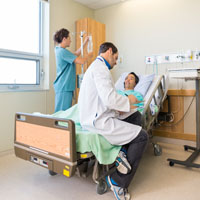Over One Million Americans Get Sepsis Every Year: What Can We Do About It?
November 16, 2017 The National Institutes of Health (NIH) report that more than one million Americans develop sepsis every year, and that anywhere from 15 to 30% of them die as a result. Sadly, the number of people who get sepsis is growing, and the NIH expects this number to continue rising in the future.
The National Institutes of Health (NIH) report that more than one million Americans develop sepsis every year, and that anywhere from 15 to 30% of them die as a result. Sadly, the number of people who get sepsis is growing, and the NIH expects this number to continue rising in the future.
Why are more and more Americans developing sepsis? The NIH has a few theories. One is that people are living longer and so more cases are present; this is because sepsis is more common among elderly individuals who suffer from chronic conditions. Another reason is the increase in antibiotic-resistant infections, which can lead to the development of sepsis. Lastly, organ transplants have become more common and accessible. As with any other procedure that requires the use of immune suppressing medications, the risk of sepsis increases.
Certain people are at a higher risk for getting sepsis than others are, such as the elderly, infants, children, people with compromised immune systems and those who have different types of cancer, AIDS or liver disease. Sepsis is characterized by an individual’s overwhelming immune response to infection. Usually when a person develops an infection, their body sends out white blood cells to fight it. But when a person becomes septic, their body releases chemicals into the bloodstream too reactively and the response causes widespread inflammation throughout their system.
The inflammation caused by sepsis can create other major health complications, like blood clots, leaking blood vessels, nutrient deprivation of the organs, oxygen deprivation and organ damage. In some cases, sepsis causes low blood pressure and as a result, a person develops septic shock. Septic shock is a very dangerous condition that can cause multiple organ dysfunction syndrome and organ failure as well as death.
In order to diagnose sepsis, a doctor will see what types of symptoms are present. He or she may also order tests for the patient’s white blood cell count and determine if bacteria is present or not. If you suspect that you or a loved one is at-risk for developing sepsis or is showing symptoms, you should immediately alert a medical professional. Typical symptoms of sepsis include:
- Rapid breathing and heart rate;
- Fever;
- Patches of discolored skin;
- Breathing problems;
- Chills due to a fall in body temperature;
- Disorientation or confusion; and
- Unconsciousness
One of the main reasons that doctors struggle to diagnose sepsis in patients is because its primary symptoms are also the symptoms of other problematic conditions, but there are other reasons that doctors sometimes fail to recognize or diagnose cases of sepsis in patients as well. The National Center for Biotechnology Information (NCBI) reports that there is no sepsis-specific test to give, so medical professionals are forced to diagnose the condition using other screening tools. Another common problem is a false-negative: if a patient was recently given a course of antibiotics it may cause a culture test to come back negative, misleading nurses and doctors.
Unfortunately, sepsis can inflict long-term consequences, even if a person is diagnosed and treated in time. Because sepsis can cause kidney damage, a person may end up requiring lifelong dialysis treatments. Medical data also shows that people with a history of sepsis are at increased risk for other subsequent dangerous infections and even death. Even when a person recovers from sepsis, his or her life may never be the same due to lingering injuries or illnesses.
Sepsis can develop as a result of any other type of infection, although the Sepsis Alliance (SA) reports that some of the most common culprits are pneumonia, urinary tract infections and the flu virus. Therefore, one effective way to combat the rising sepsis rate is to get vaccinated against preventable viruses. The SA also stresses the importance of properly caring for all wounds, ensuring the proper use of prescription antibiotics (e.g. taking the full course at recommended times, etc.), hand washing and making a doctor’s appointment when an illness or infection is suspected. If you are interested in finding out other ways to prevent sepsis and other dangerous infections, have a discussion with your doctor.
We all expect to receive safe and helpful medical care when we see a doctor, enter a hospital, or are admitted to another facility for treatment. However, medical staff can make mistakes that result in catastrophic damages – and even death – to their patients. Medical malpractice is the result of a hospital, doctor or other healthcare professional being negligent or failing to give the standard care to their patient that causes harm, injury or death to a patient. Examples of medical negligence include errors or mistakes in diagnosis, treatment, aftercare or health management. If you believe that you may be a victim of medical malpractice or negligence, please contact a representative at our firm.
Allentown Medical Malpractice Attorneys at Galfand Berger, LLP Pursue Recoveries for Victims of Dangerous Medical Errors
If you or someone you love has developed sepsis or another serious infection while in a healthcare facility and believe that a failure to diagnose or medical negligence is responsible for the injuries, we encourage you to contact our Allentown medical malpractice attorneys. Galfand Berger has offices located in Philadelphia, Bethlehem, Reading and Lancaster, and we serve clients throughout Pennsylvania and New Jersey. To schedule a consultation, call us at 800-222-8792 or complete our online contact form.
 Google Screened
Google Screened
